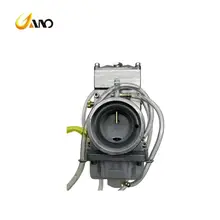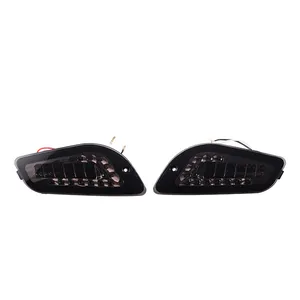A turn signal bulb is a vital element of vehicle lighting systems, indicating the intended direction of travel. This feature enhances safety by notifying other road users and pedestrians of a vehicle's planned maneuvers, such as lane changes or turns. Alibaba.com offers an extensive selection of turn signal bulbs to accommodate various vehicle makes and user preferences, each engineered for dependability, visibility, and durability.
Types and Characteristics of Turn Signal Bulbs
The assortment of turn signal bulbs encompasses a variety of models, each with distinctive attributes. The 1156 and 1157 bulbs, for example, are distinguished by their single and dual filament designs, serving different vehicular lighting roles. LED options like the 5050 are prized for their diminutive size and luminous intensity, fitting snugly into compact signal enclosures without sacrificing brilliance. Conversely, 3030 and 2835 LED chips are acclaimed for their harmonious blend of efficiency and luminosity, delivering robust illumination while conserving energy. The 4014 and 3014 LEDs are selected for their dense light output, providing potent brightness in a slender form, advantageous for contemporary vehicle aesthetics. Each variant fulfills a particular function, catering to standard road vehicles, heavy-duty equipment, or motorcycles, ensuring precise signaling needs are met.
Structure and Operation of Turn Signal Bulbs
The architecture of a turn signal bulb is a testament to sophisticated engineering, crafted to maximize visibility and dependability. Central to the bulb is the LED chip, the primary luminescence source. This chip is affixed to a circuit board that modulates the electric current, maintaining steady luminance and averting overheating. Encasing the chip is an aluminum shell, which not only safeguards the internal mechanisms but also acts as a heat sink, essential for the bulb's longevity. This shell is typically coupled with a lens that concentrates the light into a focused beam, augmenting the signal's conspicuousness. The entire unit is designed for effortless installation across diverse vehicle models, embodying a plug-and-play ethos.
Materials and Properties
The materials chosen for turn signal bulbs are purposefully selected to enhance performance and endurance. LEDs are composed of semiconductor materials that radiate light upon the passage of an electric current. The aluminum in the housing is preferred for its superior thermal conduction, crucial for managing heat in high-intensity lights. This material also boasts lightness, resistance to corrosion, and robustness, ideal for withstanding the rigors of the road. The lens is usually crafted from premium polycarbonate, noted for its transparency and resistance to impacts, ensuring the light's output remains unobstructed.
Business Usages and Applications
Turn signal bulbs are indispensable across various commercial sectors. In the automotive realm, they are essential for vehicle assembly and aftermarket enhancements. Within logistics, they are pivotal for the safe operation of truck fleets and delivery vehicles, reducing accident risks due to inadequate signaling. For enterprises focusing on vehicle refurbishment or customization, these bulbs offer the chance to modernize older models with advanced, efficient lighting. Their sturdy construction and broad applicability also render them fit for agricultural and construction vehicles, which demand dependable signaling in demanding conditions. By bolstering safety and visibility, these bulbs add business value by diminishing the likelihood of expensive mishaps and operational interruptions.
Functions and Tasks
The principal role of a turn signal bulb is to communicate the driver's navigational intentions. Beyond this core purpose, certain bulbs are engineered with additional capabilities. Some are equipped with a strobe feature, invaluable for emergency vehicles or as cautionary signals in perilous situations. Others boast dual-color functionality, enabling them to double as turn indicators and daytime running lights, thus obviating the need for separate units.
Features and Unique Selling Points
One notable characteristic of contemporary turn signal bulbs is their compatibility with Canbus systems, facilitating seamless integration with a vehicle's onboard electronics. This feature prevents common issues associated with non-compatible LEDs, such as hyper-flashing. Moreover, some bulbs are designed with integrated resistors, eliminating the necessity for additional load resistors during setup. The unique selling propositions of these bulbs often encompass their energy efficiency, extended service life, and the heightened safety afforded by improved visibility.
Benefits and Positive Outcomes
The advantages of employing LED turn signal bulbs are numerous. They significantly reduce power consumption compared to conventional bulbs, potentially lowering fuel usage and, by extension, operational expenses for vehicle owners. LEDs' instantaneous activation offers quicker alerts to other motorists, enhancing response times and decreasing accident risks. Additionally, the extended lifespan of LEDs translates to fewer replacements, yielding cost savings and environmental benefits.
How to Choose the Right Turn Signal Bulb?
Choosing the appropriate turn signal bulb requires knowledge of the vehicle's specifications, such as bulb size, socket type, and voltage needs. It is also crucial to consider the desired luminosity and the vehicle's LED compatibility. For businesses, opting for bulbs with wide-ranging compatibility can cater to a diverse customer base.
How to Install Turn Signal Bulbs?
Installation of a turn signal bulb is generally a simple affair. The procedure entails removing the existing bulb from its socket with a twist-and-pull action, followed by inserting the new bulb in its stead. Careful handling is imperative to prevent damage and ensure the new bulb is firmly connected to the socket. For LED bulbs, verifying the polarity may be necessary, and if needed, the bulb should be rotated 180 degrees to establish a proper connection.
How to Maintain and Ensure Longevity of Turn Signal Bulbs?
To preserve turn signal bulbs, regular checks for functionality and signs of dimming or erratic behavior are recommended, as these may signal the need for replacement. Keeping the bulb and its enclosure clean from debris and ensuring efficient heat dissipation can also extend the bulb's lifespan. For LED variants, minimizing exposure to moisture and extreme temperatures can avert early failure.
Target Audience and Meeting Needs
The intended market for turn signal bulbs spans a wide spectrum, from automotive manufacturers in need of premium components for new vehicles to aftermarket parts distributors serving car aficionados eager to enhance their vehicle's illumination. These bulbs are designed to satisfy the demands of such a varied clientele by offering a spectrum of choices that differ in brightness, energy conservation, and installation simplicity. This ensures that whether the end-user is a private car owner or a commercial vehicle operator, there is a turn signal bulb tailored to their specific needs.











































 浙公网安备 33010002000092号
浙公网安备 33010002000092号 浙B2-20120091-4
浙B2-20120091-4